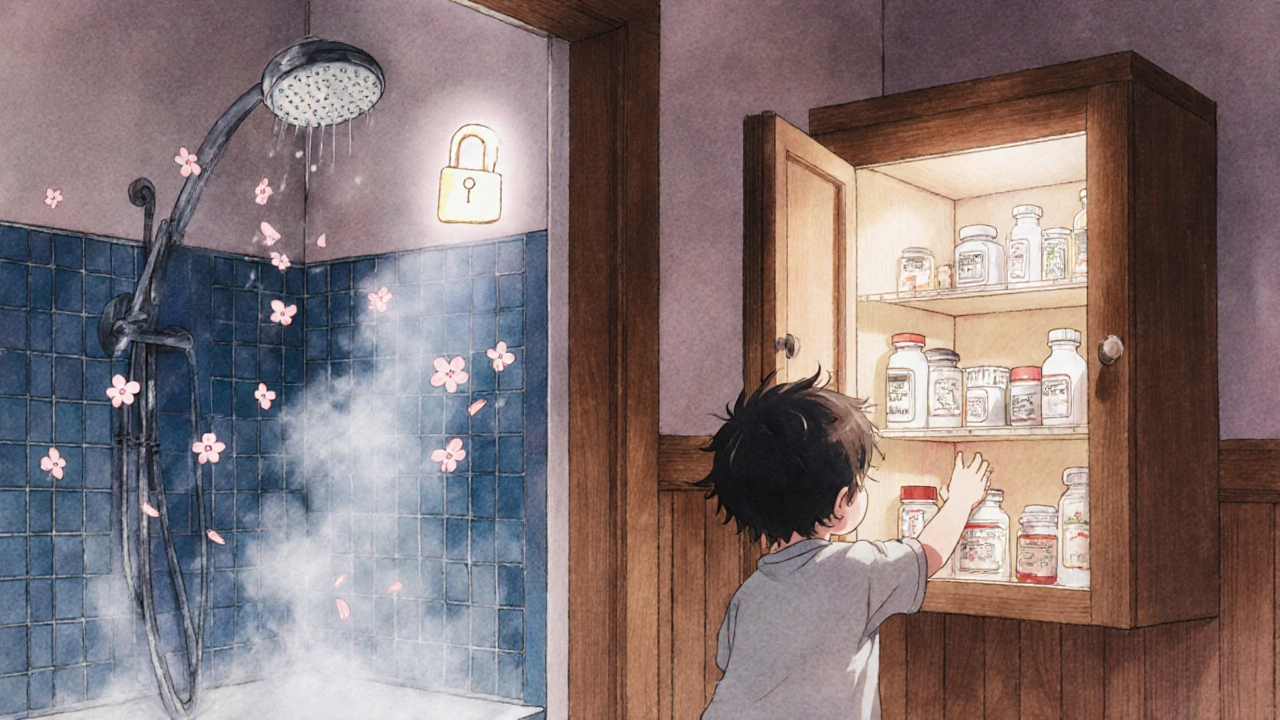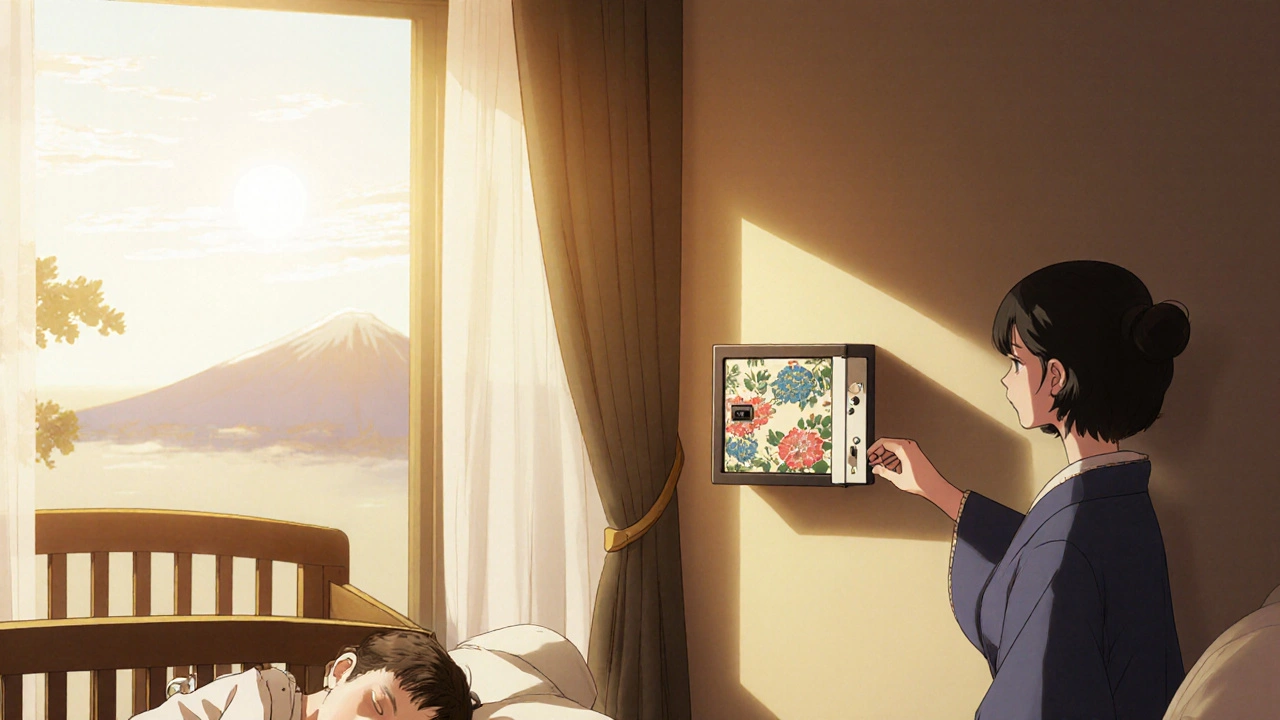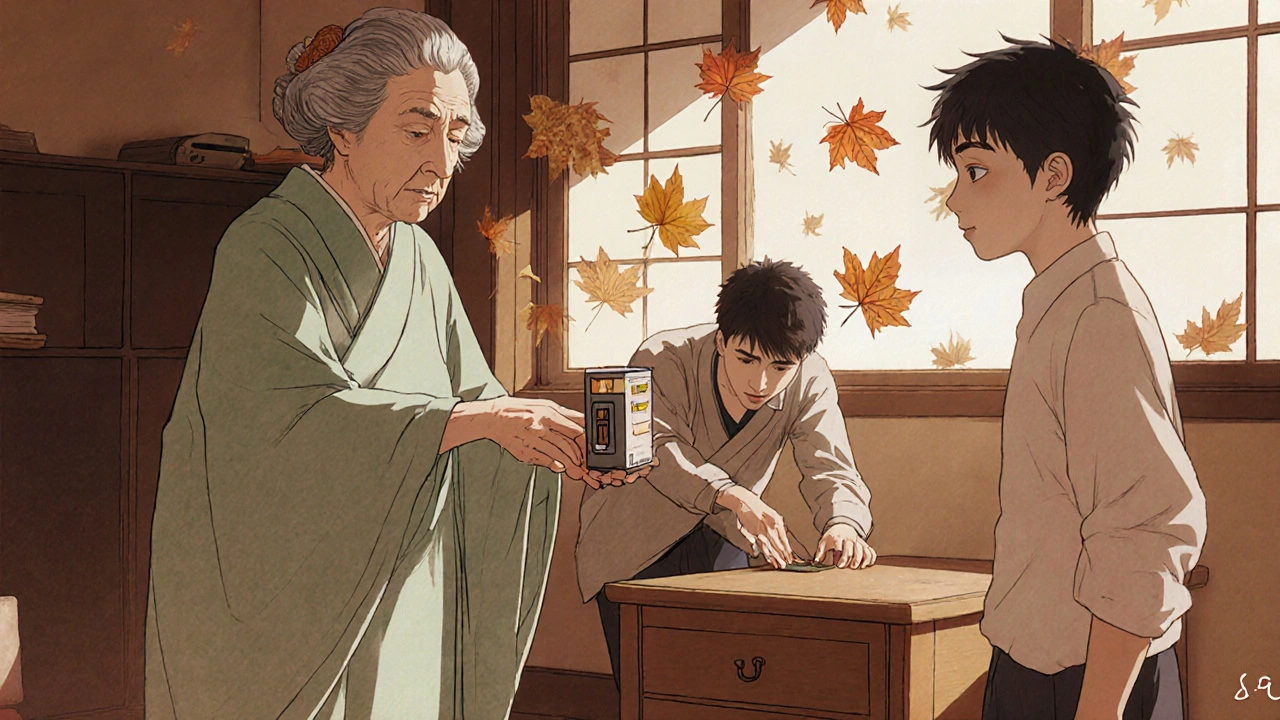Where to Store Your Medications at Home Safely: A Practical Guide for Families

Every year, 60,000 children under five in the U.S. end up in the emergency room because they got into medications they weren’t supposed to. Most of these incidents don’t happen because of reckless parents - they happen because medicine was left out, stored in the wrong place, or assumed to be "out of reach." The truth? Your bathroom cabinet, kitchen counter, or purse isn’t safe. And neither is that high shelf your toddler climbed to reach.
Why Your Medicine Cabinet Is the Worst Place to Store Pills
You’ve probably heard it before: "Keep meds in the bathroom." It’s easy. It’s convenient. And it’s dangerously wrong. Bathrooms are humid. Showers send moisture levels soaring past 80%. That moisture doesn’t just make your towels damp - it breaks down pills. According to MedlinePlus, 67% of common medications lose effectiveness within 30 days when stored in a bathroom. That means your painkiller might not work when you need it. Your blood pressure pill could become unpredictable. Insulin? It’ll spoil fast. And it’s not just about potency. The CDC reports that 68% of households store medications in bathroom cabinets. That’s the number-one mistake families make. It’s also the most accessible spot for kids. A child as young as 24 months can climb onto a toilet seat or pull open a cabinet. Even if you think the door is "too high," don’t assume it’s safe. Kids are clever. They use chairs. They stack towels. They figure it out.The Gold Standard: Locked Storage
The only reliable way to keep medications away from children, pets, and teens is to lock them up. Not just a cabinet with a latch - a real lock. The EPA, FDA, and Washington State Department of Health all agree: locked cabinets, closets, or safes are the minimum standard. You don’t need a fancy safe. A basic medicine safe costs between $20 and $150. Many are small enough to fit on a shelf, heavy enough to bolt to the floor, and strong enough to resist a 50-pound force - the standard set by Underwriters Laboratories. Some even come with biometric locks that only open with your fingerprint. A 2022 University of Michigan study found these digital locks are 78% effective at stopping unauthorized access. If you already have a gun safe, fireproof document box, or locked drawer in your bedroom, use it. These are better than any medicine cabinet. In fact, 18% of rural households already use gun safes for meds, according to the CDC. If you’ve got it, use it.What About High Shelves or Out-of-Sight Spots?
"I put them on top of the fridge." "I keep them in my coat pocket." "They’re in the drawer behind the towels." These aren’t safe. They’re just less obvious. Children climb. They explore. They watch adults. If they see you take a pill from your purse, they’ll try to do the same. The Washington State Department of Health found that 73% of pediatric poisonings happen when meds are stored in purses, on counters, or in unlocked cabinets. And here’s the kicker: 42% of poisonings occur within 5 to 10 minutes after a dose is taken - right when the bottle is sitting on the nightstand or kitchen table. Even if you think your child isn’t curious, they are. Kids don’t know the difference between candy and medicine. To them, a colorful pill is a treat. A gummy vitamin? That’s a snack. A blue pill? Same thing.
Temperature and Humidity: The Silent Killers
Medications aren’t like wine - they don’t age well in heat or moisture. The ideal storage temperature is between 68°F and 77°F (20°C to 25°C). Humidity should stay under 60%. That means:- Don’t store pills in the car - even in winter. Temperatures swing from freezing to over 120°F in parked vehicles.
- Don’t keep them in the garage or basement unless it’s climate-controlled.
- Keep insulin, EpiPens, and other temperature-sensitive drugs in the fridge - but in a locked container, separate from food.
Keep the Original Bottle - Always
Never transfer pills to a pill organizer unless you’re using it for daily doses - and even then, only for short-term use. The original bottle has the National Drug Code, expiration date, dosage instructions, and warnings. If a child swallows something and you don’t know what it is, you can’t tell the ER. You need that label. Also, make sure the cap is child-resistant. The Poison Prevention Packaging Act requires caps that take 17.5 pounds of force to open. But here’s the catch: 50% of kids can open them by age five. That’s why locking the container is non-negotiable. The cap is a backup, not a solution.Special Cases: Grandparents, Dementia, and Multi-Generational Homes
If you live with older adults, especially those with dementia, locking everything up can be tricky. They might forget where they put their meds - or need them quickly. Seattle Children’s Hospital says that in these cases, you need a balanced approach. Here’s what works:- Use a daily pill dispenser with a lock, set up by a caregiver.
- Keep the main supply locked, but give the person a small, labeled container with just today’s pills.
- Use a digital dispenser that logs when someone opens it - so you know if it’s being used correctly.

What About Unused or Expired Medications?
Don’t flush them. Don’t toss them in the trash. Don’t pour them down the sink. The EPA and FDA both warn that flushing meds pollutes water systems. Throwing them in the trash? Kids and pets can dig them out. Instead:- Find a drug take-back program. Many pharmacies, hospitals, and police stations offer free drop-off bins.
- If no take-back is available, mix pills with coffee grounds or cat litter in a sealed bag before tossing.
- Remove or black out personal info on the bottle before recycling.
What You Can Do Today
You don’t need to overhaul your home. Start with one step:- Go to every room. Look under sinks, in drawers, on nightstands, in purses, in the car.
- Collect every pill bottle - prescription, OTC, vitamins, supplements.
- Find a locked box, cabinet, or safe. Put them all in there.
- Put the key or code somewhere only adults know.
- Return every bottle to the lock after each use.
Final Thought: It’s Not About Trust - It’s About Prevention
You trust your kids. You trust your parents. You trust your house is safe. But accidents aren’t about trust. They’re about access. A locked box isn’t paranoid. It’s practical. It’s responsible. It’s the difference between a normal day and an emergency room visit. Start today. Lock it up. Then sleep better tonight.Can I store medications in the kitchen?
Yes - but only if it’s a locked cabinet away from the stove, sink, or windows. The kitchen can be a good spot if it’s cool, dry, and out of reach. Avoid storing meds near the dishwasher or microwave, where heat and steam can damage them. Never leave bottles on counters, even for a few minutes.
What if I have a baby or toddler at home?
If you have a child under five, locked storage isn’t optional - it’s essential. Children in this age group are the most at risk. Keep all medications - even baby acetaminophen - in a locked container. Never leave a syringe or dropper out after use. Store them in the same place every time so you never forget.
Are child-resistant caps enough?
No. Child-resistant caps are required by law, but they’re not child-proof. Studies show half of children can open them by age five. Some can do it in under 10 seconds. Locking the entire container is the only reliable protection.
Should I lock up vitamins and supplements?
Yes. Many vitamins, especially gummies, look like candy. Iron supplements can be deadly to young children in small doses. Even omega-3s or melatonin can cause serious side effects if taken in large amounts. Treat all pills like medicine - lock them up.
How do I know if my medication has gone bad?
Check the expiration date and look for changes: pills that are cracked, discolored, or smell strange. Liquids that are cloudy or have particles. If you’re unsure, don’t risk it. Take it to a pharmacy for disposal. Storing meds in humid or hot places is the #1 reason they degrade.
What should I do if my child swallows a pill?
Call Poison Control immediately at 1-800-222-1222 (U.S.) or your local emergency number. Don’t wait for symptoms. Don’t try to make them vomit. Have the pill bottle ready - the label has critical info. If you can’t find the bottle, describe the pill’s color, shape, and any markings. Time matters - act fast.
